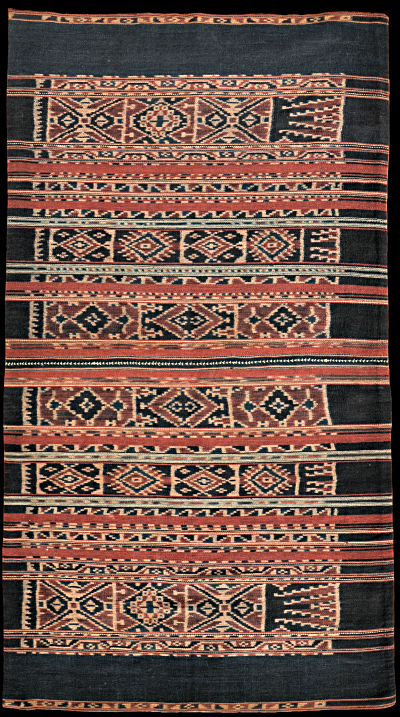| |
 
 | | | |
247 Solor Archipelago, Lembata
Kewatek (sarong)  
| | Locale: | Atadei, Lamaholot people. | | Period: | Ca. 1900 | | Yarn: | Cotton, hand-spun, medium | | Technique: | Warp ikat | | Panels: | 2 | | Size: | 68 x 123 cm (2' 2" x 4' 0") LW: 1.81 | | Design: | Kewatek nai ruo, two-panel bridewealth sarong. The motifs are nearly all unusual for Lembata, and invite further study. The triangular motifs with multiple legs are very different from the more common rendering of tumpal motifs in the region. Curiously, a similar rendering, though with only two legs per open triangle was seen in a late 20th c. sarong made on Pantar. The open triangles with what appear to be tentacles on Ternate represent sea hares (Aplysia, clade Anaspidae), and may well do so also on Lembata, two islands over. All hand-spun cotton, including the pinstripes, some of which were done in the pale greenish blue (someone suggested 'mintyish') which is found on Lembata, Alor, Ternate and Pantar, and nowhere else to our knowledge. | | Comment: | Rare early example. Only a few specimens of this quality are known. Few of the motifs belong to the common repertoire. There is no patola emulation that can be immediately identified. The inward pointing tentacles are similar to the sea hares of Ternate (Peni and McIntosh 2020), but far more elaborate. The second and third motifs from the left in the widest ikated bands appear to consist of two mirrored tena, boat motifs, merged at their keels. Ex-collection August Flick. | | Background: | Chapters on Solor Archipelago and Lembata. | | Sources: | Similar to kewatek from the fourth quarter of the 19th c. in the Washington Textile Museum, identified as Lama Lerap, Acc. no 68.19. As the style of that cloth is similar to high end Atadei cloths, the identification could be in doubt. Similar to kewatek in Gittinger, Splendid Symbols, Fig. 131, identified only as Lembata. Similar to kewatek nai Ruo in Barnes, The Ikat Textiles of Lamalera, Plate II, but far more intricate, as one would expect from a cloth made in Atadei, where technical standards in general are high, arguably the highest on the island. | | |

©Peter ten Hoopen, 2025
All rights reserved.
|
|


